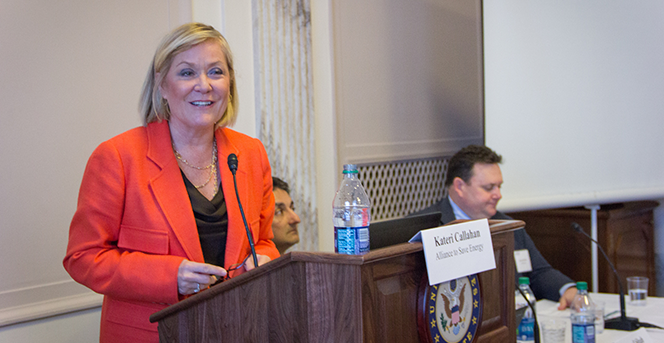Congressional Briefing Write Up: A Glimpse of New Trends in Energy Efficiency
Let's Save Energy
Alliance to Save Energy's Blog

The Alliance to Save Energy hosted a Capitol Hill briefing on Thursday, January 14, entitled Cutting Edge Technologies and Businesses: Opening the Door for Energy Efficiency Deployment at Scale. Topics covered included new technologies and trends, the role of data, and the crucial importance of a prepared workforce. Read on for a summary of important ideas and emerging trends from the briefing’s dynamic panel of speakers.
New and Emerging Trends
A central theme to the panelist discussions revolved around innovation and the emergence of new ideas and technologies. While this certainly includes improvements to existing technologies and methods, there are also exciting possibilities currently under development that have the potential to expand beyond traditional limitations. According to Roland Risser, program director at the U.S. Department of Energy’s Building Technologies Office, energy-efficient technologies are in development that will employ a novel magnetic system to cool and heat food more efficiently, and that dryers, which haven't changed substantially in many years, may use vibration instead of heat to dry clothes more efficiently. Explaining that the energy efficiency space is one that is constantly undergoing innovation and evolution, Risser suggested that these above-mentioned technologies are only the tip of the iceberg.
Another emerging trend under development is the growing importance of human comfort in energy-efficient building design. Brandon Tinianov, vice president of business development at View, said, “Designers at the front end are ever more factoring occupant comfort into their evaluation of a building’s performance.” Dave Oberholzer, vice president of business and partner development at Weatherbug, a company that provides live weather data to companies and consumers to allow buildings to more efficiently heat and cool themselves according to weather patterns, agrees. Oberholzer said, “Consumers sometimes think energy efficiency is about being less comfortable. In fact, most consumers report that ours is the most comfortable thermostat they've used. And they save energy and money.”
Another topic touched on during the panels was distributed generation, or electricity generated by a variety of small sources such as solar, wind, waste or geothermal that are directly incorporated into a building or a home. Panelists explained that implications from distributed generation, including how, where and when energy is produced and consumed, and how these changes impact utilities, power generation companies, and consumers, will be an increasingly important factor to navigate moving forward. Swapnil Shah, president and CEO of First Fuel, noted that with the multiple energy sources that are available today, distributed energy management (coordinating the use of different energy sources in the most energy-efficient way) is a trend that will evolve over the next five years. The Alliance anticipates that distributed energy management has the potential to generate new business opportunities for private companies and new ways to save energy and money for energy consumers.
Operational Changes
Efforts to improve energy efficiency do not need to be monumental or costly to be effective. Panelists were quick to emphasize that simple changes to the way buildings are operated continue to be an invaluable and often untapped source of money and energy savings. Shah emphasized this, saying, “Half the savings for any average building is achievable through operational changes.” Shah went on to cite an example in which half of the $25 million of energy-saving opportunities his company identified for a particular client were through operational savings. He added that these changes typically don’t require any capital investment and are often as straightforward as programming high and low “set points” (selected temperature ranges) into a thermostat, or turning off lights and air conditioning overnight, or while the building is unoccupied.
Randy Newton, vice president of Enterprise Engineering at Ingersoll Rand, explained that 70 percent of the buildings that will exist in 2050 have already been built today. “If we want to achieve energy efficiency, we need to figure out how to do so with existing buildings,” Newton said. “The next big thing may not be miracle technology, but technology that exists today.”
Data
The effectiveness of energy efficiency improvements cannot be measured without a detailed understanding of energy usage. Therefore, it should come as no surprise that a key factor identified by the panelists is the availability of real-time energy consumption data. Shah emphasized that the traditional means of data collection is no longer adequate, noting that it would take thousands of “person-years” to perform in-person energy efficiency audits on the millions of commercial buildings in the United States today. So, what is the solution? The answer, according to Shah and other panelists, lies in tapping into real-time data. Shah explained that smart meters typically measure energy consumption in a building every five or ten minutes, providing at least 36,000 yearly data points. This data, in turn, can be used to inform adjustments to the operation of the building in real time.
While data collection has become increasingly instrumental in the energy efficiency space, it has also brought with it new challenges. Risser explained that cyber security is a major challenge in the energy efficiency space that is not going away. Furthermore, he explained, understanding how to protect user data will be a key component in scaling “connected buildings”, or buildings with devices that communicate with each other and the internet.
Preparing the Workforce
The innovation surrounding energy efficiency is constantly changing, which necessitates the continued advancement of education and training programs for these new technologies. Newton pointed to adequate education for engineers as a significant hurdle and explained that a good place to start is by increasing training on modeling software. Modeling software, which is used during the construction phase to estimate the potential energy and water use of a building, is vitally important to efficiency in buildings. Many existing buildings, according to Newton, could achieve reductions in energy use between 20-50 percent through better modeling of heating, ventilation and air conditioning (HVAC), lighting and windows. Because modeling was once at best imprecise, many buildings have excess air conditioning capacity built in to protect against human error, Newton stated. This need not be the case anymore, Newton emphasized. “It all starts with good modeling software.”
Mary Ann Piette, Director of the Building Technology and Urban Systems Division at the Lawrence Berkeley National Laboratory (LBNL), agrees. “We can design a building’s components to work together efficiently, but people must understand how to use them,” she said. Piette added, “Technicians and community college educators will need new training.” LBNL has recently provided educational workshops with local community colleges in order to spread knowledge.
STAY EMPOWERED
Help the Alliance advocate for policies to use energy more efficiently – supporting job creation, reduced emissions, and lower costs. Contact your member of Congress.
Energy efficiency is smart, nonpartisan, and practical. So are we. Our strength comes from an unparalleled group of Alliance Associates working collaboratively under the Alliance umbrella to pave the way for energy efficiency gains.
The power of efficiency is in your hands. Supporting the Alliance means supporting a vision for using energy more productively to achieve economic growth, a cleaner environment, and greater energy security, affordability, and reliability.



